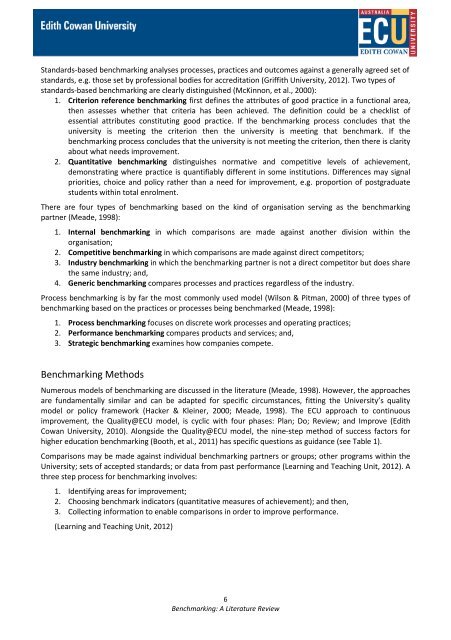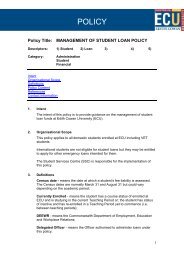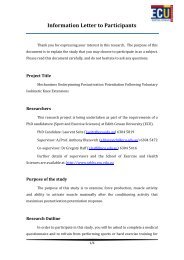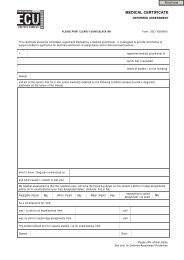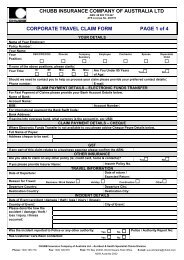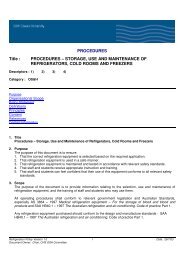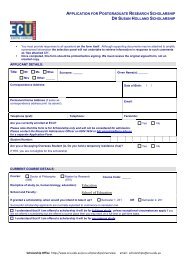Benchmarking: A Literature Review - ECU | Sign In : Portals - Edith ...
Benchmarking: A Literature Review - ECU | Sign In : Portals - Edith ...
Benchmarking: A Literature Review - ECU | Sign In : Portals - Edith ...
You also want an ePaper? Increase the reach of your titles
YUMPU automatically turns print PDFs into web optimized ePapers that Google loves.
Standards-based benchmarking analyses processes, practices and outcomes against a generally agreed set ofstandards, e.g. those set by professional bodies for accreditation (Griffith University, 2012). Two types ofstandards-based benchmarking are clearly distinguished (McKinnon, et al., 2000):1. Criterion reference benchmarking first defines the attributes of good practice in a functional area,then assesses whether that criteria has been achieved. The definition could be a checklist ofessential attributes constituting good practice. If the benchmarking process concludes that theuniversity is meeting the criterion then the university is meeting that benchmark. If thebenchmarking process concludes that the university is not meeting the criterion, then there is clarityabout what needs improvement.2. Quantitative benchmarking distinguishes normative and competitive levels of achievement,demonstrating where practice is quantifiably different in some institutions. Differences may signalpriorities, choice and policy rather than a need for improvement, e.g. proportion of postgraduatestudents within total enrolment.There are four types of benchmarking based on the kind of organisation serving as the benchmarkingpartner (Meade, 1998):1. <strong>In</strong>ternal benchmarking in which comparisons are made against another division within theorganisation;2. Competitive benchmarking in which comparisons are made against direct competitors;3. <strong>In</strong>dustry benchmarking in which the benchmarking partner is not a direct competitor but does sharethe same industry; and,4. Generic benchmarking compares processes and practices regardless of the industry.Process benchmarking is by far the most commonly used model (Wilson & Pitman, 2000) of three types ofbenchmarking based on the practices or processes being benchmarked (Meade, 1998):1. Process benchmarking focuses on discrete work processes and operating practices;2. Performance benchmarking compares products and services; and,3. Strategic benchmarking examines how companies compete.<strong>Benchmarking</strong> MethodsNumerous models of benchmarking are discussed in the literature (Meade, 1998). However, the approachesare fundamentally similar and can be adapted for specific circumstances, fitting the University’s qualitymodel or policy framework (Hacker & Kleiner, 2000; Meade, 1998). The <strong>ECU</strong> approach to continuousimprovement, the Quality@<strong>ECU</strong> model, is cyclic with four phases: Plan; Do; <strong>Review</strong>; and Improve (<strong>Edith</strong>Cowan University, 2010). Alongside the Quality@<strong>ECU</strong> model, the nine-step method of success factors forhigher education benchmarking (Booth, et al., 2011) has specific questions as guidance (see Table 1).Comparisons may be made against individual benchmarking partners or groups; other programs within theUniversity; sets of accepted standards; or data from past performance (Learning and Teaching Unit, 2012). Athree step process for benchmarking involves:1. Identifying areas for improvement;2. Choosing benchmark indicators (quantitative measures of achievement); and then,3. Collecting information to enable comparisons in order to improve performance.(Learning and Teaching Unit, 2012)6<strong>Benchmarking</strong>: A <strong>Literature</strong> <strong>Review</strong>


